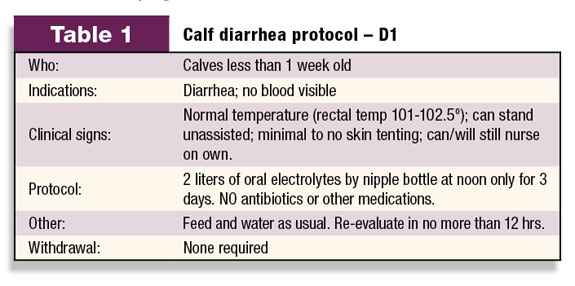The use of antibiotics and analgesics (pain medication) in the dairy industry is coming under increased scrutiny by regulators. Although other commodities have primarily been targeted in the past, a 2008 USDA Food Safety and Inspection Service study on meat residues found that dairy market (cull) cows and bob veal calves were responsible for a majority of the problems detected at slaughter. This has resulted in various groups wondering aloud if it would not be easier just to exclude the bob veal and market dairy cow from the food chain.
If the dairy industry wants to continue to have the opportunity to sell animals for beef, members of the meat industry and regulatory officials will expect (and perhaps soon demand) that dairy producers reduce the number of animals with residues, blemishes and defects entering slaughter plants.
In Pennsylvania, about 20 percent of an average dairy farm’s income comes from “non-milk” sources, such as bob veal and market cows. This is a small but significant portion of the gross income on most farms, and the opportunity to ship animals into the beef market also provides an excellent and convenient outlet for animals that otherwise have very limited or no economic value on a dairy farm.
Dairy producers should not overlook the importance of handling these animals in a manner that recognizes their economic value and the fact that these animals are ultimately destined for the dinner plates of consumers.
Having a hectically busy schedule, or arguing that bob veal and market cows are not a major source of income, is not an acceptable excuse for selling animals that do not meet quality and safety standards
However, these and other reasons do present real challenges for each farm to develop a simple, effective and efficient method to medicate animals as needed, while maximizing the quality and safety of the beef produced from those animals when they are marketed. Developing a protocol-based treatment system is one method to achieve these goals.
Undoubtedly, many dairy producers have heard the pitch for treatment protocols, and some have even taken the time and effort to develop a set for their farm. One of the factors driving this has been the increase in labor force that often accompanies herd expansion.
Unfortunately, treatment protocols are often put in a binder and filed away on a shelf, never again to be used, reviewed or updated.
Experience shows that on many dairies a systematic method for matching appropriate therapy to clinical signs, as well as records of animal treatments, withholding and withdrawal times are seriously lacking.
When residue violations are discovered at the slaughter plant and investigated by regulatory officials, there are almost always a few common denominators at the farms from which the animals came.
Some of the most usual are: inadequate identification of the animal, poor records to indicate withdrawal or withholding times, extra-label use of products with no or minimal guidance/oversight and few (if any) records to match the date, animal, clinical condition, therapy and withdrawal times.
Adopting and following a list of therapeutic protocols is a simple yet effective strategy to help eliminate most of these inadequacies.

For an example of protocols for sick calves, see Table 1 .
The producer, in conjunction with a veterinarian, would develop a short list of conditions commonly seen on the farm, as well as a concise set of protocols to deal with these situations.
Most producers already have some “standard treatment protocols” in their heads, but they have often not had these evaluated by their veterinarian.
Writing these protocols down is also the first step in making sure that effective, efficient protocols are consistently being followed by everyone responsible for treating animals. A set might be developed for mastitis of increasing severity (e.g., M1, M2, M3), for pneumonia in calves, pneumonia in cows, lameness in cows, etc.
In this manner, commonly encountered conditions would have a simple protocol which includes clinical signs, therapeutics at appropriate dose (mg/kg), route of administration (e.g., intravenous or intramammary, etc.), duration of treatment, withdrawal and withholding times.
For complicated or unusual conditions, very detailed and complicated protocols could be developed, or these could be handled as special situations by the herd veterinarian and/or the most trained person on the farm.
Treatment protocols should be reviewed periodically by the herd’s veterinarian (at least every six to 12 months), who should have a valid Veterinary-Client-Patient relationship (VCPR) with the farm, preferably documented by a signed VCPR form.
To keep track of treatments, a dairy producer should record – on a calendar, in a computer program or in a notebook – the date, animal ID, protocol number, the name of the person implementing the protocol and the date when the withholding/withdrawal will be complete.
In the current market and regulatory environment, having concise and complete animal treatment records (including withholding and withdrawal dates) is extremely important – using treatment protocols is one way to accomplish that easily and efficiently. And make sure you save the records in whatever format you have them … preferably for at least a couple of years.
That way you can show the inspector/regulator, if and when they show up at your door, that you are, and have been, committed to marketing high-quality, residue-free animals.
Farms that, with their veterinarian, have taken the initiative to implement good protocols and records are to be applauded, not only for protecting their own interests but also for contributing to a positive image for the dairy industry. Farms that have not yet done so should be aware they are placing themselves at risk for more severe regulatory action should residues be found in their animals. PD
References omitted due to space but are available upon request to editor@progressivedairy.com .
—Excerpts from Penn State Dairy Digest, April 21, 2011
Dr. David R. Wolfgang
Extension Veterinarian
Penn State University
drw12@psu.edu
Ernest Hovingh
Penn State University
eph1@psu.edu







